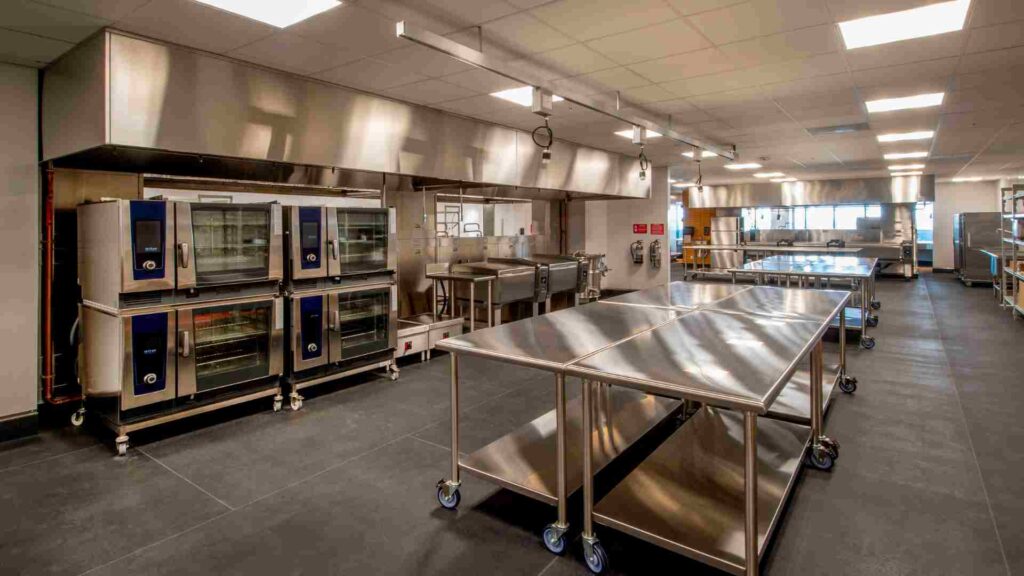How to Start a Cloud Kitchen from Home

Ever thought of opening your restaurant but were burdened by the extreme cost and risk it entailed? Well, great news! Times are changing in the food industry, and a new trend is here to be the most simple thing ever: “cloud kitchens.” In this article, we will look at what cloud kitchens are, their associated benefits, and How to Start a Cloud Kitchen from home.
Food delivery has grown astronomically over the past years, with more people ordering food online today than ever. Be it a home cook who wants to scale up on their passion from within the four walls of their kitchen or a new professional chef wanting a new venture, starting a cloud kitchen could be your ladder to success in the food industry.
Also due to strong competition, high startup costs, complex regulations, and red tape involved in opening an on-premise restaurant, a growing number of people are investigating cloud kitchen options.
People see it as the easiest and safest way to have their delicious food delivered and served whenever it’s convenient for them, so it has a lot of promise. But you may find it challenging to start a cloud kitchen!
The cloud kitchen, sometimes referred to as ghost eateries, ghost kitchens, or black kitchens, appears to be a benefit for businesses that would prefer to test new concepts without incurring significant initial expenses.
Join us as we explore the journey to unlocking the mysteries of How to Start a Cloud Kitchen, starting with picking the perfect spot and becoming a pro at promoting your food online.
Let’s get started!
What is a Cloud Kitchen?

A cloud kitchen is essentially a food prep facility where people prepare, either for delivery or takeout, a variety of menu items. Unlike traditional restaurants, these kinds of kitchens have no dining area or storefront.
This can be either in the form of commercial kitchen spaces or even commercial/home kitchens running independently to prepare and send away only food bought by consumers through online order aggregators or personal websites.
Here are some critical aspects of a cloud kitchen:
- The delivery-only model: A cloud kitchen does not offer a dine-in option at all—it essentially works on preparing food to be sent to a consumer’s location either via delivery or take-out.
- Extent through online presence: Digital infrastructure in cloud kitchens is used for taking orders, marketing, and interacting with the customer.
- Menu flexibility: There is no sticking a fixed menu on the wall. A cloud kitchen is agile about changing menus in tune with demand and trends.
- Reduced overhead costs: Eliminating the dining area and front-office staff radically reduces the operational cost.
- Data-driven operations: Cloud kitchens often use technology to adjust their menus, inventory costs, and delivery functions based on customer buying data.
Benefits of Cloud Kitchens
Starting a cloud kitchen has a lot of upper hands over the traditional restaurant models. Let’s sight a few major ones:
Reduced Costs
The single biggest benefit of cloud kitchens is that the upfront investment required is significantly lower. You don’t have to worry about spending on a dining space, expensive furniture, or fancy decorations. You can use all your resources for the most vital kitchen equipment and ingredients.
Lowered Overheads
Running a cloud kitchen involves much lower costs as compared to that for a traditional restaurant. There is no need for prime locations, large staff requirements, and no need to maintain dining areas for seating.
Flexibility in menu and pricing
More significant reach means not being tied down by the menu, and cloud kitchens can experiment with cuisines, dishes, and pricing strategies easily. You can keep up easily with changing customer tastes, shifts in preferred seasonal ingredients, and new market trends.
More flexible reach
Cloud kitchens have the potential to attract so much more business than restaurants, which have geographic limitations and depend on the ordering platforms and distribution services. You serve customers over a bigger geographic area and therefore can potentially make more sales and a wider brand reach.
Pay more attention to food quality
By eliminating these operational distractions, cloud kitchen operators can just focus their time and attention on what matters—making delicious, high-quality food.
Result Oriented
Cloud kitchens are platforms that derive significant customer information from their online ordering platforms. With this information, you will be in a position to make informed decisions about menu optimization, pricing, and marketing.
More than one branding opportunity
A single cloud kitchen can be host to many kinds of virtual restaurant brands at the same time. This means that you can cater to different segments of customers or sell different kinds of food—all without needing to invest in separate real estate.
A Guide to How to start a Cloud Kitchen
Step 1. Develop Your Concept

To begin with, decide upon the type of food one wants to serve. Think about your culinary skills, market demand, and competing offerings. These could be anything from gourmet burgers, to healthy salads, or ethnic cuisines.
However before you launch a cloud kitchen, you should do a lot of research on the business key terms.
It involves studying the market, figuring out what customers want, and judging possible competitors. You ought to look at your budget and make an extensive strategy for how much you can spend on your cloud kitchen.
Step 2. Write a Business Plan

A good business plan is going to be the one leg your cloud kitchen stands on. Describe your unique abilities in detail and how you plan to separate yourself from your competitors.
The business plan should include information of the target market, financial projections, marketing strategies, and operational plans of the business.
Step 3. Secure Funding

Estimate how much money you will require to set up your cloud kitchen. Although it is less costly than a traditional sit-down restaurant, you will still have to raise the finances required to buy kitchen equipment, food ingredients, and packaging supplies, and organize preliminary marketing campaigns.
Step 4. Find a perfect Home Space

Find a perfect kitchen space at your home that follows health and safety regulations. Most cities have shared kitchen spaces that are just perfect for cloud kitchens.
Alternatively, you might convert some part of your home into a commercial kitchen, provided local laws allow it.
Step 5. Get the Required Licenses and Permits

Research and acquire all relevant licensing and permits to run a food business in your area, including but not limited to a general business license, a food handler’s permit, and health department certification.
Also Learn about the rules about food safety, cleaning, and health checks. You can make sure you are following the law by thinking about the lawyers and government bodies you can ask for help.
Step 6. Kitchen Setup

Investing in top-grade kitchenware, appliances, and food storage options. Ensure that the waste disposal, drainage, and ventilation systems are operating efficiently.
Buy quality kitchenware that will meet your menu needs; this can be ovens, stoves, refrigerators, and food preparation surfaces of all types. The need for good ventilation and fire safety equipment is always a top priority.
Also, Cloud kitchens should make an important investment in recruiting the best chefs to satisfy customers with mouthwatering meals. Since dine-in is not an option, restaurants may do without servers, hosts, and other staff.
Give detailed coaching on how to prepare food, how to keep people safe, and how to treat customers right.
Make your work environment a place where people value working together, talking to each other, and making progress.
Step 7. Menu Design

Design a menu that will not only taste great but also travel well. Think about the kind of packing, temperature control, and presentation while conceptualizing dishes.
- Find out what your customers like and what new food trends are happening.
- Keep an eye on what your competitors are selling and how people are feeling on social media.
- Learn useful things that will help you make menus and come up with marketing plans.
Step 8. Integration with Delivery Services

Register yourself with popular food delivery services in your region, such as Uber Eats, Zomato, or Swiggy, which come with the benefit of expanding your reach to more customers and taking charge of the delivery logistics.
There are a lot of people that use these services, and they are actively searching for the most convenient lunch options.
It will be a lot easier for potential customers to find your menu, make an order, and taste your delicious foods without any difficulty if you include your Cloud Kitchen on these Food Delivery apps.
Step 9. Build Online Presence

Having a strong online presence matters in the present digital era if you want to contact clients and make sales. Make a professional website that lists your menu, costs, and ways to place orders.
You must build a website for your cloud kitchen and open social media pages. Utilize these platforms to share your menu, and customer reviews, and get engaged with your customers.
To improve user experience and boost visibility, make your website mobile-friendly and submit it to search engines.
Get benefits of Instagram , Facebook & Twitter!
Step 10. Launch and Test
Soft launch to test operations and get customer feedback. Use this to fine-tune your menu, operations, and customer experience.
How to Select a Cloud Kitchen Marketing Agency

As your cloud kitchen business grows, you’ll have to consider potential tie-ups with marketing agencies. Here is how you will decide on the right one for your business:
1. Evaluate Your Marketing Needs
Before trying to find an agency, determine your marketing objectives. Do you need help with social media management, search engine optimization, content creation, or paid advertising? Understanding your needs will help you find an agency that specializes in the field you desire.
2. Look for Industry Experience
Engage an agency that has experience working with other key players in the food and beverage industry, and preferably, other cloud kitchen business clients. They will be more attuned to your niche’s unique challenges and opportunities.
3. Look at Their Portfolio
Review their previous work, including case studies. Look for success stories similar to yours, accompanied by quantifiable results.
4. Assess Their Digital Marketing Capabilities
Make sure that the following skills are found at the Digital Marketing agency and are important for a cloud kitchen:
- Social media marketing Services,
- SEO,
- PPC advertising,
- Email marketing,
- Content creation,
- Food photography and videography.
5. Look out for Data-driven Strategies
The best agencies use data to guide their strategies and decisions. Ask them how they gather and analyze data to make sure that the marketing efforts are more effective.
6. Look for Client Reviews and Testimonials
Look at the reviews and testimonials their clients are giving. By this, you can get immense insight into the quality of work, dependability, and results yielded by them.
7. Learn the Price Structures
Assess the pricing model of the agency and ensure it works within your budget. While some work on a flat fee model, most of them work on either a retainer or performance-based model.
Suggested Read: Pro tips to create a small business budget
Final Words
Establishing a cloud kitchen from home would create a good opportunity for many, in a way, to enter the world of the culinary arts with much lower risk and costs compared to starting a traditional restaurant. Going down the delivery-only route proves you can develop your passion for cuisine into a prime business right from your kitchen.
So buckle up, see this as a lesson, listen to the customers, and keep adapting to the change in market demands. Done right, your cloud kitchen will make deliveries to thousands of customers looking for a delicious meal, and you will be able to build a sustainable, profitable food business from home.
FAQs
Do I need special permits to run a cloud kitchen from home?
Yes, you usually need food service permits and may be required to comply with some specified health department requirements concerning home-based food businesses.
How much money does it take to set up a cloud kitchen from home?
When it comes to expenses, the spectrum ranges from $3,000 to $25,000, depending on the needs for equipment and local regulations.
Can I use food delivery apps for my home-based cloud kitchen?
Yes, almost all food delivery apps are open to having home-based cloud kitchens onboard, but you will have to meet their requirements and probably prove you have the proper permits.
How should I best go about marketing my home-based cloud kitchen?
Social media marketing, local SEO, affiliations with food ordering and delivery apps, and the cultivation of customer reviews to create an online image and help draw in customers.
